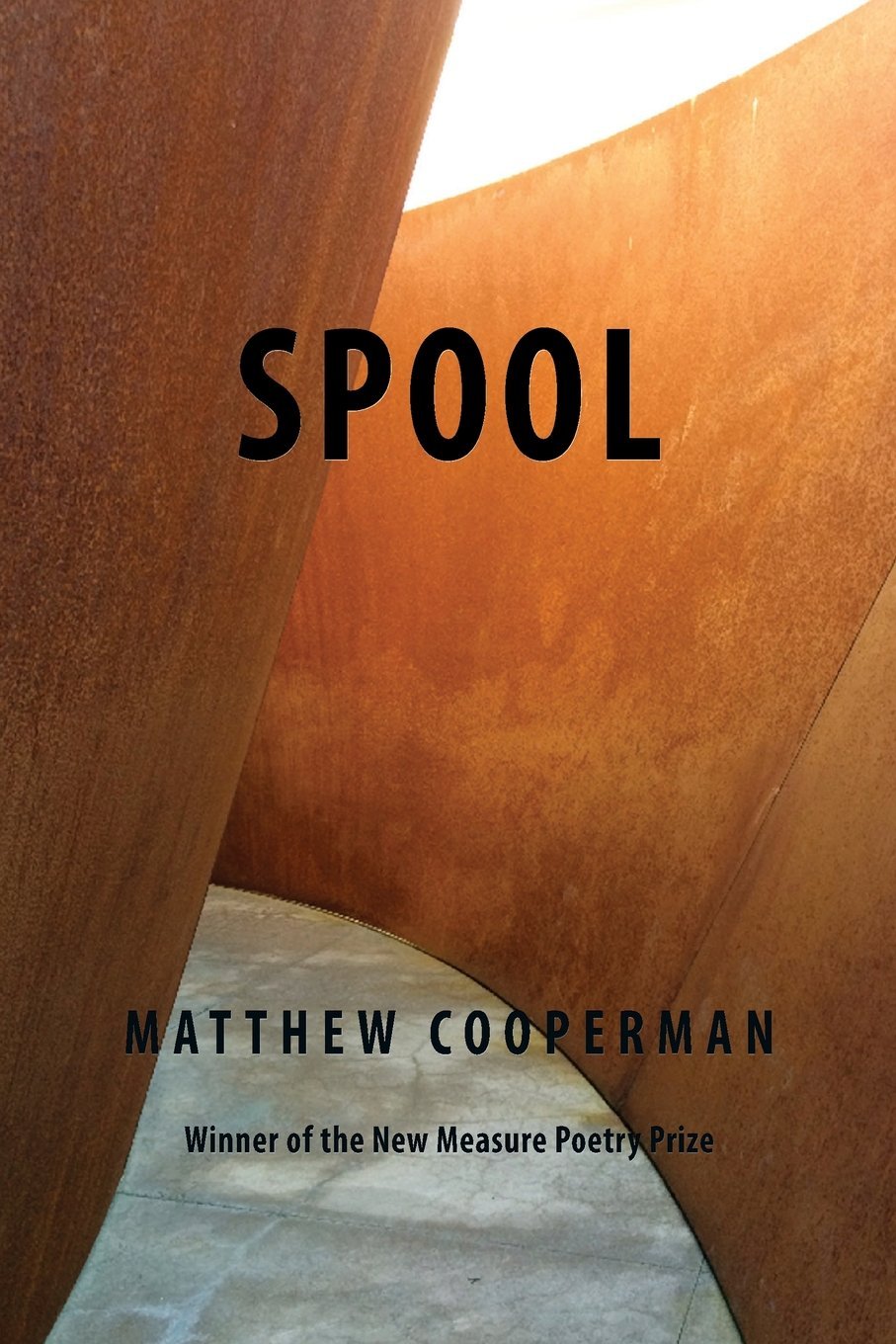SPOOL

by Matthew Cooperman
Parlor Press, 2015
120 pages
Review by Peter Burzynski
Matthew Cooperman’s Spool, winner of the New Measure Poetry Prize, is a captivating and challenging book that presses the boundaries of narrative by exploiting an almost unchanging form and a smart yet curious tone. It is a book that is at times philosophical and at others personal in its grateful gestures towards the author’s poetry mentors. These long, narrow poems reach across the page and each sub-section finishes neatly without spilling, or unspooling, onto the next page. Some poems change font size and style to shout or mock the sincerity of an elevated tone. It’s not quite a grotesque text à la Mark Bibbins or Daniel Borzutzky, but it weaves the clever and the quotidian as well as it explains physics and the body politic of human interaction. Furthermore, Spool’s title is apropos since the poems are wound and spun together at the same time they unspool and become tangled with each other.
The titles and order of these poems evince how this book was constructed. The table of contents list three sections with the first featuring: “Spool 16,” “Spool 20,” “Spool 24,” “Spool 4,” “Spool 14,” “Spool 23,” “Spool 5,” and “Spool 6.” This may suggest that the poems and perhaps even the sections are interchangeable entities, but one encounters more than a hint of narratorial structure as each spool follows naturally into the next. The project conjures images of a Victorian-era twine factory with dark towers of machine slowly turning fiber into string. This book functions much like that factory as it takes the dust of fiber and melds them into tangible bits of rope—albeit rope that is a bit frayed. Perhaps a missed opportunity in the book’s structure is that it allows for certain more poignant spools to repeat. For example, the masterful “Spool 25” could have had a whole new meaning at the beginning of the book, where it may have functioned as a gateway that teaches readers how to enter the project as a whole. Its final page length section reads:
and soul clap
hands and sing
and louder sing
this vowel lust
spool it off—time is domestic
its velocity quarks
a total cosmiccentrifugal my little
girl’s girl her
wavering eyes and
watery calm this
sould side climax
wants to clap
she and me
a raveling spore
in every darkness
a visible calm
our rhizome ring
in the dust (80)
As if the breathtaking imagery weren’t enough, the line breaks of this poem tug at the hearts of eyes and artfully utilizes the imperative mode as the book often transforms nouns into unique verbs. The imperative mode is frequent throughout this book, but it is not heavy-handed or listy as so many imperative poems can be.
Other particularly enjoyable poetry nerd moments can be found in “Spool 22,” whose page section features starkly different forms despite maintaining the consistent narrowness of line. The first section is structured like a short New York School poem while others bend like a concrete poem in the shape of a flame or another with one-line stanzas. The latter is the more unusual for this book as many of these poems flex along the left margin, but few escape single stanza form. As with “Spool 25,” the most intriguing section is the last where the author explores simple, beautiful truths:
permeable boundaries are
where immigrants thrivewith concern there
and fence evocations
confront you who
and where from
in the scheme
of things areexits like conduits
accelerate the phenotype
we are more
or less immigrants
thrice removed wediscovered out tombs
to be gardens
rimmed by blocks
living testaments or
sweet flag tenementsthe laundry snaps
these living signs
a lively debate
about forgetting remember
your lost trace
my living grace (62)
The awkward syntax of the second stanza highlights and propels the reader through the smoothness of the third and fourth. The word play in the fourth stanza gives us well-wrought sound and structure to savor and then the aphasiac “your lost trace” riffs off “your lost race” given the poem’s grasping attempt to understand what it means to be within and to transgress national and colonial boundaries. This poem changes nothing, but instead politely confronts identity and place by exploring where socio economic cultural identity determines place and access to space.
Many of these poems are cleverly wrought with turns of phrase and spoofed clichés. There are moments, though, where the reader may grow weary of the self-awareness of the poem’s shining poetic technique. For example, the final section of “Spool 21” begins:
bar and rebar
again and again
wall wills stability
they are made (94)
It is clear that this poem is attempting to create a meta-commentary on structure, but at this moment it feels like it's trying too hard.
Despite such a fleeting moment of micro-annoyance, this is indeed a brilliantly built book which can be casually philosophical and unabashedly beautiful all at once. I recommend this read for any interested in anti-lyric or even very minimally L=A=N=G=U=A=G=E based poetics. Spool balances the line of contemporary poetry between the abstract and the image. Its equivalent in painting would be a contemporary work that exploits Modernist techniques without being full-blown color studies, but rather creatively hewn content-based pieces. If this book has any seams, they remain invisible. If there are flaws, we quickly read past them as the pages unspin and respool in our hands.
Return to table of contents.
